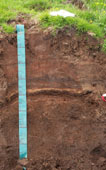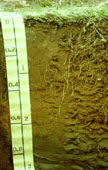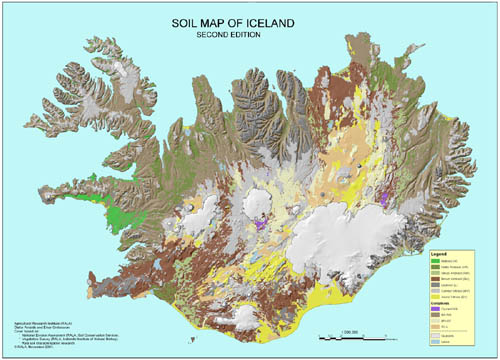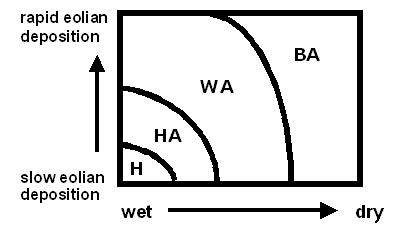ICELANDIC
SOILS
Soils that
form in materials that are rich in volcanic ash are called Andisols (US) or Andosols
(FAO), see also www.rala.is/andosol.
Andosols have unique properties, some of which are responsible for their erosion
susceptibility. The soils have low cohesion but can absorb large quantities of water
(>100% on dry weight basis). This high water holding capacity intensifies freezing
effects that result in solifluction, landslides, needle ice formation, and the formation
of hummocks ("thufur"). The lack of cohesion make the soils extremely vulnerable
to rain-splash and running water, especially when the soils are water saturated. The soils
tend to be super-saturated in winter and spring when a frozen layer prevents drainage.
Wind erosion is further intensified by lack of cohesion, stable silt-sized aggregates, and
often low density of soil grains, especially coarse tephra grains (often about 1 g/cm3).

Histosol
|

Histic Andosol
|

Brown Andosol
|

Vitrisol |
One
click on image to enlarge |
Volcanic
eruptions are frequent in Iceland, and volcanic ash deposits are widespread. In addition,
there are vast unstable sandy areas near glacial margins and along floodplains of glacial
rivers. The volcanic and glacial deposits are subjected to intense eolian activity. Where
vegetation stabilizes eolian materials on the surface, they accumulate on top of the
soils. The surface is therefore gradually rising, commonly at the rate of 0.1-1 mm each
year. Direct deposition of volcanic ash also contributes to this deposition. The rate
increased dramatically at the time of settlement. As the soils gradually became thicker,
they also became less stable.

One
click on image to enlarge
Print
soilmap in Acrobat Reader - Soilmap
(460 Kb).
Save to your computer, Click the right button on your mouse over the hyperlink
"Soilmap" and select "Save target as".
The Agricultural Research Institute has produced a soil map in 1:250 000. A preliminary
version may be seen on this page. The soil information underlying the map is drawn from
published literature on Icelandic soils as well as unpublished data. Some general
characteristics are presented in the Table below.
The soil classes used in the map are as follows:
Histosols
(H)
Histosols are dominated by organic materials. A
minimum of 20% C is chosen, as is used in WRB for Andosols (FAO, 1998). The organic materials are usually fibric in nature
but are often more decomposed at lower depths The Icelandic Histosols can be deep and >
7 m profiles have been identified. The
Histosols also receive considerable eolian additions of andic nature in contrast to most
other arctic and sub-arctic Histosols and Histic Cryosols
Histic Andosols (HA)
Histic Andosols are found in poorly drained areas with relatively small eolian additions
on an Icelandic scale, but enough to reduce the organic content below the 20% C limit for
Histosols. As they are often far from eolian
sources and active volcanoes, the eolian materials are fine grained. Typical allophane content is 2–10% and all
the soils meet the (Al+½Fe)ox criteria for Andosols.
Gleyic
Andosols (WA)
Andic soil materials carry a distinct set of attribute soil properties that separate
Andosols from other soils. Wetland Andosols
are separated from other Andosols in Iceland as Gleyic Andosol at the highest taxonomic
level. Gleyic Andosols include a variety of wetland soils that have
lower organic content than 12% in surface horizons. Allophane
content is quite variable, from a few percent to > 20%.
Oxidation/reduction features are often well expressed, especially at the boundaries
of tephra layers, with distinct textural changes between the tephra and the soil above and
below. This soil type is dominant in wetland
areas in the central highlands where eolian deposition is relatively rapid.
Brown Andosols (BA)
Brown Andosols are the classical freely drained Andosols in Iceland, and perhaps the most
studied to date. They are often 0.5–2 m
thick and have considerable allophane content, especially where the soil environment is
relatively stable (15–30%). Ferrihydrite
is also common, with Feox ranging from 1% to 8 %. Both dark basaltic and light-colored rhyolitic
tephras are often quite distinct within the profiles.
Vitrisols (V)
Vitrisols include a range of soils that contain less than 1%
organic carbon or less than 1% Siox. The
surface usually has limited plant cover, often 5–10%.
These surfaces are desert-like, and commonly have a stone pavement caused by frost
heaving of coarse fragments. The Icelandic
Vitrisols are rather unique, as these deserts exist under moist climatic conditions and
temperatures that otherwise sustain vegetation growth (Boreal and Sub-Arctic climate). The characteristics of the Vitrisols in Iceland
were recently reviewed by Arnalds and Kimble (2001).
The soils are sandy and shallow and the mineralogy is dominated by volcanic glass. The soils often occur together with Leptosols,
where the Vitrisols have developed in shallow eolian deposits.
Leptosols (L)
Icelandic Leptosols have not been studied to date, but they include lava
surfaces with shallow eolian-andic mantle and scree slopes.
Cryosols (C)
Cryosols are defined as soils containing permanent ice, or permafrost. Permafrost and palsas are found in some highland
areas (Thorhallsdottir, 1997), but the extent of these soils has not been surveyed. The palsa areas are associated with Gleyic Andosols in the highlands.
The classification scheme is reflected by organic content and drainage. Brown Andosols (BA) are found in relatively dry
positions, regardless of eolian deposition rate. Histic
Andosols (HA) and Histosols are only found in wet poorly drained sites where eolian
deposition is slow (H) or moderate (HA). Gleyic Andosols
(HA) dominate poorly drained sites where eolian deposition is rapid, near active eolian
sources or volcanoes.

| Soil Type |
Symbol |
Icelandic term1
|
Criteria
|
SoilTaxonomy
|
WRB |
| Histosol |
H |
Mójörð |
>20% C |
Histosol |
(Andic) Cryic Histosol |
| Histic Andosol |
HA |
Svartjörð |
12-20% C |
Aquand |
Gleyic and Histic Andosol |
| Gleyic Andosol |
WA |
Blautjörð |
1-12% C ox/redox features |
Aquand or Cryand |
Gleyic Andosol |
| Brown Andosol |
BA |
Brúnjörð |
1-12% C |
Cryand |
Haplic Andosol |
| Vitrisol |
V |
Frumjörð |
<1%
C; or <1%Siox and <2% C |
Cryand |
Vitric Andosol.
Also Arenosols and Leptosol |
| Cryosol |
C |
Frerajörð |
Permafrost |
Gelisol |
Cryosol |
| Leptosol |
L |
Bergjörð |
Shallow2 |
Entisol |
Leptosol |
1: Icelandic term is only
suggestive. 2: Includes scree slopes.
Extent of Icelandic soil types (and complexes of soil
types)
| Soil type |
Symbol |
Extent (km2) |
% of soils |
| Histosol |
H |
1090 |
1.2 |
| Histic Andosol |
HA |
4920 |
5.5 |
| Gleyic
Andosol |
WA |
2390 |
2.6 |
| Brown Andosol |
BA |
13360 |
14.8 |
| Leptosol |
L |
7310 |
8.1 |
| Cambic Vitrisols |
MV |
17640 |
19.5 |
| Arenic Vitrisols |
SV |
4550 |
5.0 |
| Cryosols – WA |
C-WA |
140 |
0.2 |
| |
BA-WA |
28080 |
31.1 |
| |
MV-SV |
6000 |
6.6 |
| |
SV-L |
4790 |
5.3 |
| Total |
|
90270 |
100 |
(Glaciers and lakes not included)
Typical range for selected soil properties
| Type |
BD(g cm-3) |
C (%) |
pHH2O |
pHNaF |
Alox(%) |
Feox(%) |
Siox(%) |
| Histosol (H) |
0.15-0.4 |
20-40 |
4-5.5 |
9-10.5 |
0.7-1.6 |
0.8 |
0.2 |
| Histic Andosol (HA) |
0.2-0.4 |
13-18 |
4.5-5.5 |
9-10.5 |
1-3 |
1-5 |
0.4-1 |
| Gleyic Andosol (WA) |
0.3-0.8 |
1-12 |
4.5-7.2 |
10-11 |
1.3-4 |
1-7 |
1-1.7 |
| Brown Andosol (BA) |
0.5-0.8 |
2-7 |
5.5-7.5 |
9.5-11.5 |
1.3-7 |
1-8 |
0.4-5 |
| Vitrisol (V) |
0.8-1.2 |
<1 |
7-7.9 |
9 |
0.4-2 |
0.4-3 |
0.4-3 |
Edited by Olafur Arnalds
and Einar Gretarsson
Agricultural Research Institute of Iceland.
www.rala.is
Last updated on 02.09.2004 by EG
|




